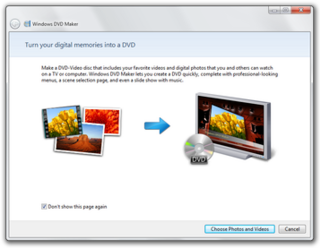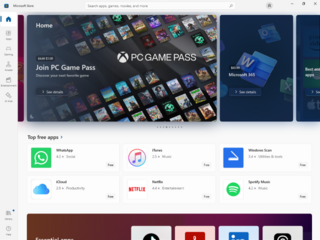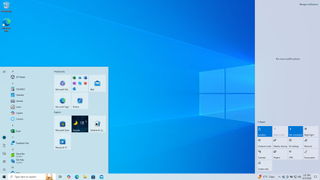Microsoft Windows was announced by Bill Gates on November 10, 1983. Microsoft introduced Windows as a graphical user interface for MS-DOS, which had been introduced two years earlier. The product line evolved in the 1990s from an operating environment into a fully complete, modern operating system over two lines of development, each with their own separate codebase.
Microsoft Windows is a group of several proprietary graphical operating system families developed and marketed by Microsoft. Each family caters to a certain sector of the computing industry. For instance, Windows NT for consumer and corporate desktops, Windows Server for servers, and Windows IoT for embedded systems. Defunct Windows families include Windows 9x, Windows Mobile, Windows Phone, and Windows Embedded Compact.

Windows XP is a major release of Microsoft's Windows NT operating system. It was released to manufacturing on August 24, 2001, and later to retail on October 25, 2001. It is a direct upgrade to its predecessors, Windows 2000 for high-end and business users and Windows Me for home users, and is available for any devices running Windows NT 4.0, Windows 98, Windows 2000, or Windows Me that meet the new Windows XP system requirements.
The Start menu is a graphical user interface element that has been part of Microsoft Windows since Windows 95, providing a means of opening programs and performing other functions in the Windows shell. The Start menu, and the Taskbar on which it appears, were created and named in 1993 by Daniel Oran, a program manager at Microsoft who had previously collaborated on Great ape language research with the behavioral psychologist B.F. Skinner at Harvard.

Windows Vista is a major release of Microsoft's Windows NT operating system. It was released to manufacturing on November 8, 2006, and became generally available on January 30, 2007, on the Windows Marketplace, the first release of Windows to be made available through a digital distribution platform. Vista succeeded Windows XP (2001); at the time, the five-year gap between the two was the longest time span between successive Windows releases.

Windows Anytime Upgrade was a service by Microsoft introduced in Windows Vista that facilitated upgrades across successive editions of Windows Vista. Prices for upgrades purchased through Windows Anytime Upgrade were lower than prices for upgrades purchased at retail. Windows Anytime Upgrade is included in Windows 7 to allow users to upgrade to Windows 7 editions. In Windows 8 and Windows 8.1 it was rebranded as Add Features to Windows and was used to purchase an upgrade license for the Pro edition or to add Windows Media Center to an existing Pro installation. Support for this feature was discontinued on October 31, 2015.

Windows DVD Maker is a discontinued DVD authoring application developed by Microsoft introduced in Windows Vista, available in the Home Premium and Ultimate editions of Windows Vista for users to create slideshows and videos for playback on media devices including DVD players and the Xbox 360 home video game console. It is also available in the Home Premium, Professional, Enterprise, and Ultimate editions of Windows 7, but it is no longer available as of the release of Windows 8.

Windows IoT, short for Windows Internet of Things and formerly known as Windows Embedded, is a family of operating systems from Microsoft designed for use in embedded systems. Microsoft has three different subfamilies of operating systems for embedded devices targeting a wide market, ranging from small-footprint, real-time devices to point of sale (POS) devices like kiosks. Windows Embedded operating systems are available to original equipment manufacturers (OEMs), who make it available to end users preloaded with their hardware, in addition to volume license customers in some cases.
Windows Vista—a major release of the Microsoft Windows operating system—was available in six different product editions: Starter, Home Basic, Home Premium, Business, Enterprise, and Ultimate. On September 5, 2006, Microsoft announced the USD pricing for editions available through retail channels; the operating system was later made available to retail on January 30, 2007. Microsoft also made Windows Vista available for purchase and download from Windows Marketplace; it is the first version of Windows to be distributed through a digital distribution platform. Editions sold at retail were available in both Full and Upgrade versions and later included Service Pack 1 (SP1).
Windows XP, which is the next version of Windows NT after Windows 2000 and the successor to the consumer-oriented Windows Me, has been released in several editions since its original release in 2001.
Windows 7, a major release of the Microsoft Windows operating system, has been released in several editions since its original release in 2009. Only Home Premium, Professional, and Ultimate were widely available at retailers. The other editions focus on other markets, such as the software development world or enterprise use. All editions support 32-bit IA-32 CPUs and all editions except Starter support 64-bit x64 CPUs. 64-bit installation media are not included in Home-Basic edition packages, but can be obtained separately from Windows.

Windows 8 is a major release of the Windows NT operating system developed by Microsoft. It was released to manufacturing on August 1, 2012, and was made available for download via MSDN and TechNet on August 15, 2012. Nearly three months after its initial release, Windows 8 finally made its first retail appearance on October 26, 2012.
The transition from Windows 7 to Windows 8 introduced a number of new features across various aspects of the operating system. These include a greater focus on optimizing the operating system for touchscreen-based devices and cloud computing.

The Microsoft Store is a digital distribution platform operated by Microsoft. It was created as an app store for Windows 8 as the primary means of distributing Universal Windows Platform apps. With Windows 10 1803, Microsoft merged its other distribution platforms into Microsoft Store, making it a unified distribution point for apps, console games, and digital videos. Digital music was included until the end of 2017, and E-books were included until 2019.

Microsoft Office 2013 is a version of Microsoft Office, a productivity suite for Microsoft Windows. It is the successor to Microsoft Office 2010 and the predecessor to Microsoft Office 2016. Unlike with Office 2010, no OS X equivalent was released.

Windows 8.1 is a release of the Windows NT operating system developed by Microsoft. It was released to manufacturing on August 27, 2013, and broadly released for retail sale on October 17, 2013, about a year after the retail release of its predecessor, and succeeded by Windows 10 on July 29, 2015. Windows 8.1 was made available for download via MSDN and Technet and available as a free upgrade for retail copies of Windows 8 and Windows RT users via the Windows Store. A server version, Windows Server 2012 R2, was released on October 18, 2013.

Windows 10 is a major release of Microsoft's Windows NT operating system. It is the direct successor to Windows 8.1, which was released nearly two years earlier. It was released to manufacturing on July 15, 2015, and later to retail on July 29, 2015. Windows 10 was made available for download via MSDN and TechNet, as a free upgrade for retail copies of Windows 8 and Windows 8.1 users via the Windows Store, and to Windows 7 users via Windows Update. Windows 10 receives new builds on an ongoing basis, which are available at no additional cost to users, in addition to additional test builds of Windows 10, which are available to Windows Insiders. Devices in enterprise environments can receive these updates at a slower pace, or use long-term support milestones that only receive critical updates, such as security patches, over their ten-year lifespan of extended support. In June 2021, Microsoft announced that support for Windows 10 editions which are not in the Long-Term Servicing Channel (LTSC) will end on October 14, 2025.
Windows 10 has several editions, all with varying feature sets, use cases, or intended devices. Certain editions are distributed only on devices directly from an original equipment manufacturer (OEM), while editions such as Enterprise and Education are only available through volume licensing channels. Microsoft also makes editions of Windows 10 available to device manufacturers for use on specific classes of devices, including IoT devices and previously marketed Windows 10 Mobile for smartphones.
Tips is the latest of a series of tutorial hubs in Microsoft Windows that provides information about using features. Information is presented as screenshots, text descriptions, videos, and web links. As Windows upgrades have traditionally been drastic, each version since Windows 95 has had its own tutorial app, and the name has changed frequently. Notably, the feature list shown has tended to expand as newer versions of Windows are released and the most recently released tutorial receives updates through the Microsoft Store, allowing it to receive updates more frequently than Windows itself is upgraded.









